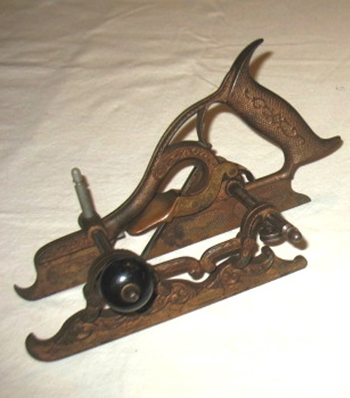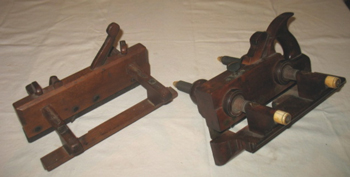Plow Planes

1)

2)

3)
By definition a plow plane is used to make grooves and rabbets, mostly for drawer bottoms and backs. It is also used to cut tongue & groove. The photos describe the different types of plow planes that have been available over the years.
In the first photo is the Stanley #45, manufactured between 1883-1962. It came with 18-23 cutters roughly half of them being plow plane or rabbet blades. They are fun to use and easy to set up. The set also came with beading blades.
The Stanley #55 which was manufactured from 1897-1963. It came with set groove and rabbet blades along with beading and many other molding cutters (total of 55). This plane was made more elaborate than the 45 and if you were in a hurry, you might be better off finding the right shaper cutter. When given enough time they are fun to use and very versatile.
The plane in photo 2, is strictly a plow and rabbet plane and is one of the most desirable planes for the collector. It is known as the type 1 #50 manufactured from 1874-1875 and patented by Charles Miller. Three variations of this plane were offered. One in cast iron with japanned finish, another in cast iron with copper wash and a third that was solid bronze. These planes have become one of the highlights in a tool collection.
Another in a series of plows patented by Miller and built by Stanley is a Type 1 #43 and was built between 1870-1872. It was just a plow + rabbet and came with 9 cutters from 1/8 to 5/8 and also a ¼ tongue cutter. This type 1 #43 is the only known example with nickel plated trimmings. Being type 1 it has the distinctive hook on top of frame. These planes are thus referenced to as “hooks.”
The third photo represents wooden planes that are the earliest variety of planes (Earliest American, since the Romans must have had a means of cutting a groove). The first one on left is a great example of a “yankee plow” and was probably made in Massachusetts around 1720-1730. The earliest documented American planes were built by F. Nicholson of Wrentham, Massachusetts. Nicholson’s apprentice was Cesar Chelor who started making planes in 1730-1731. This plow was found with several Chelors, although unmarked, it has all the right characteristics of a very early plow. The early planes were slightly longer, made of birch and had a wide flat chamfer on the body.
The plane on the right is a much later plow made by Baldwin from New York. This plane features screw arm fence adjustments and ivory tips on ends of arms. It was made between 1830-1841 over one hundred years after Nicholson.
Several other manufacturers include, but are not limited to: Walker, Mayos Patent, Philips Patent, Ohio Tool (wooden), just to name a few.
Jeff Pearson is a former wooden shipwright. He deals in old tools in Searsport, Maine. 207-322-1186.
